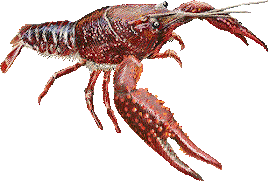Redclaw, Cherax quadricarinatus, is a species of freshwater crayfish native to the rivers of north-west Queensland and the Northern Territory.
Although well known to the locals of this isolated region of tropical Australia, it remained effectively unknown to the rest of Australia until the late 1980s. It was at that time that the first tentative steps were taken to farm freshwater crayfish in Queensland, although initially the endeavours were applied to an imported species, the marron, from Western Australia.
It was abundantly evident after a short period that the cool-water marron was unsuitable for Queensland conditions, and the native redclaw was suggested as an alternative.
Redclaw proved to be well suited to cultivation, and the Redclaw Aquaculture Industry was born, developing quickly and spreading throughout Queensland, south to NSW and westwards into the Northern Territory. Now, 15 years on, the industry has a solid foundation and has runs on the board, reflecting its commercial viability and potential for substantial growth.
Redclaw is advantaged by a host of physical, biological and commercial attributes which make it an excellent candidate for aquaculture.
It is a physically robust species with broad geographic potential, has a simple life-cycle and straight-forward production technology, requires simple foods and is economic to produce.
The texture and flavour of the flesh compares very favourably with other commonly eaten marine crustaceans, and having the appearance of a lobster, is positioned at the premium end of the crustacean market spectrum.
While current production at around 80 tonnes per annum is primarily marketed domestically, the growth potential for the industry lies with the substantial export demand for this product.
Given that viable production technologies are now established, the challenge for the industry is to increase production, through expansion and new investment, to lift production volumes to a point where the substantial quantities required by identified export markets can be consistently supplied.
Although a native Australian, redclaw's excellent aquaculture attributes have seen it exported to several other countries where commercial production has now been established. In the short-term this will be to Australia's advantage in increasing the market profile of this new product.
Longer term, Australia will maintain a production advantage based on access to the broad genetic pool of native stocks, sustainability due to thorough environmental regulations and isolation from recognised diseases which have decimated off-shore industries.
Redclaw aquaculture in Australia is poised for significant expansion. The basic resources of suitable land and water are readily available throughout northern Australia, and could potentially support production of several thousands of tonnes. Production technologies are now well developed, and 'best practice' methods have been defined.
These technologies are relatively straight-forward and the skill levels required of practitioners are not onerous. Nevertheless, a background in farming and/or qualifications and experience in aquaculture are a distinct advantage.
Good supporting documentation and training are readily available. The challenge for the industry is to increase production, through expansion and new investment, to lift production volumes to a point where the substantial quantities required by domestics and export markets can be consistently supplied.
Markets and marketing issues
The Redclaw industry is faced with several marketing challenges.
Typical of most fledgling industries, very little promotion has been undertaken, thus consumer awareness both domestically and overseas is relatively low.
The industry is composed of a great number of small enterprises making the marketing quite fragmented. Recently, localised marketing groups have emerged consisting of several cooperative growers with common purpose. They have established quality standards, brand names and promotional material to more effectively market their collective production in a coordinated manner.
In Australia Redclaw are commonly marketed in 20 g size grades ranging from 30-50 g (at approximately AUD11.50/kg) to greater than 120 g (at approximately AUD19.00/kg). The smaller grades are commonly used in buffet style presentations, with the larger animals featuring in a-la-carte restaurants, both as entree and main course dishes.
Export opportunities have been identified through considerable market research. However, sales to date have been limited by the small production volume and therefore the risk of inconsistent supply.
At present 50 percent of redclaw are sold within Queensland, 45 percent interstate and 5 percent are exported.
There are three steps in the marketing chain; producer, wholesaler and restaurateur. There is effectively no retail sale of the raw product. While selling direct to restaurants may result in slightly higher prices paid, the practise can have a limiting effect on market growth. A good wholesaler can increase the market penetration of Redclaw by cross-selling while servicing customers from their existing product lists. Farm-gate sales are substantial, however, the volumes are likely to decrease as more coordinated marketing through wholesalers develops. Wholesalers have tended to position Redclaw on the price scale lower than marine lobsters but higher than prawns.
Generally they are marketed alongside Moreton Bay bugs and small champagne lobsters or scampi. A clear marketing attribute for redclaw is its reputation as a product from clean water, free of medical or chemical additives. Product is purged prior to sale and is often held in saltwater which improves the flavour and its attractiveness to Asian markets.
Redclaw are largely sold as a live product, although some processing, particularly cooking and freezing is undertaken. Fresh redclaw have a smooth lustrous shell, deep blue to green in colour, with males exhibiting a bright red colouring on the margins of their large claws. Cooked, they present as bright red, typical of premium crustaceans.
Monday, September 14, 2009
Subscribe to:
Post Comments (Atom)





No comments:
Post a Comment